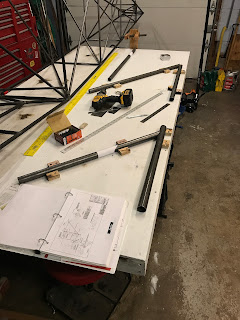Last updated November 8th, 2022!? Time sure gets away from you sometimes, doesn't it. Woof..
A lot of time was spend figuring out main landing gear legs. The first step was taking the info from the Piper drawings and laying out the gear v's full size on my table, then jigging the parts in place.
This is what we're building. The left side of the picture would be facing the front of the aircraft.
And here's the jig laid out on my table. The nearer jig sets the relationship between the forward tube and the axle. The farther jig aligns the forward and rear tube as well as the bushings on which the gear leg will pivot.
With the jigs laid out it's time to manufacture parts. First came the pivot bushings, and they were a bit of a process. First the little U-shaped piece of metal that holds the bushing needs to get bent to shape. I made a little die the right size to bend the material in my vice. After the U is bent it then gets a notch ground out to fit around the bushing and the bushing is welded in. The jig has bolts pushed through the table where the bushings go to register them properly.
Tubing is then slid up against the bushing assemblies, marked, and cut to fit. Paper patterns from an online tube-notching calculator help get everything cut to the right shape. The next problem is one of fitting the tubing to the bushing assembly. The tubing is round (obviously) but the base of the assembly is square. Leaving it like this would make welding them together and adding the subsequent reinforcement strap very difficult. I took some scrap tubing and tried a couple different techniques to make them fit together. Ultimately I was able to heat the end of the tube 1/4 at a time and hammer it flat until I got a pretty even square shape.















Comments
Post a Comment